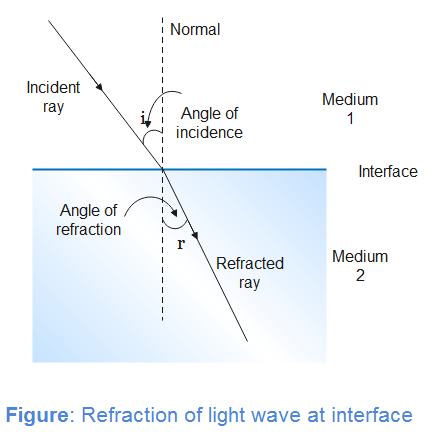
The angle of incidence in air for a light ray is 40 degrees. If the ray travels through water of refractive index 4/3. Find the angle of refraction.
($\sin {{40}^{{}^\circ }}=0.643$)
Answer
557.4k+ views
Hint: The relationship of angle of incidence and angle of refraction at interface of two media is given by Snell’s law. Snell’s law states that the ratio of the sines of the angles of incidence and refraction is equal to the reciprocal of the ratio of the indices of refraction.
Use Snell’s law to find the angle of refraction.
Formula used:
Law of refraction or Snell’s law, $\dfrac{\sin {{\theta }_{1}}}{\sin {{\theta }_{2}}}=\left( \dfrac{{{\mu }_{2}}}{{{\mu }_{1}}} \right)$
Complete step-by-step answer:
When a light wave passes at some angle from one medium to another medium, its direction changes. This phenomenon is referred to as refraction.

Angle of incidence is defined as the angle between incident ray and normal to the interface of the media and angle of refraction is the angle between refracted ray and normal as shown in figure.
Angle of incidence and angle of refraction are related by Snell’s law. Snell’s law states that the ratio of the sines of the angles of incidence and refraction is equal to the reciprocal of the ratio of the indices of refraction.
$\dfrac{\sin i}{\sin r}=\left( \dfrac{{{\mu }_{2}}}{{{\mu }_{1}}} \right)$
We are given that angle of incidence $i={{40}^{{}^\circ }}$ refractive index of medium 2 which is water is ${{\mu }_{2}}=\dfrac{4}{3}$. We know that the refractive index of air is ${{\mu }_{1}}=1$. Substituting these values in Snell’s law, we have
$\dfrac{\sin {{40}^{{}^\circ }}}{\sin r}=\dfrac{4/3}{1}$
On rearranging and solving the above equation, we get
$\sin r=\dfrac{3}{4}\sin {{40}^{{}^\circ }}=\dfrac{3}{4}\times 0.643\approx 0.48$
Therefore, angle of refraction is $r={{\sin }^{-1}}\left( 0.48 \right)$
Note: The law of refraction or Snell’s law is valid for all pairs of media at the point of incidence. Incident ray, normal and refracted ray lie in the same plane.
Refractive index of a medium is a unitless quantity. It is also defined as the ratio of velocity of wave in the medium to velocity of wave in vacuum. Refractive index of air or free space is unity.
Use Snell’s law to find the angle of refraction.
Formula used:
Law of refraction or Snell’s law, $\dfrac{\sin {{\theta }_{1}}}{\sin {{\theta }_{2}}}=\left( \dfrac{{{\mu }_{2}}}{{{\mu }_{1}}} \right)$
Complete step-by-step answer:
When a light wave passes at some angle from one medium to another medium, its direction changes. This phenomenon is referred to as refraction.

Angle of incidence is defined as the angle between incident ray and normal to the interface of the media and angle of refraction is the angle between refracted ray and normal as shown in figure.
Angle of incidence and angle of refraction are related by Snell’s law. Snell’s law states that the ratio of the sines of the angles of incidence and refraction is equal to the reciprocal of the ratio of the indices of refraction.
$\dfrac{\sin i}{\sin r}=\left( \dfrac{{{\mu }_{2}}}{{{\mu }_{1}}} \right)$
We are given that angle of incidence $i={{40}^{{}^\circ }}$ refractive index of medium 2 which is water is ${{\mu }_{2}}=\dfrac{4}{3}$. We know that the refractive index of air is ${{\mu }_{1}}=1$. Substituting these values in Snell’s law, we have
$\dfrac{\sin {{40}^{{}^\circ }}}{\sin r}=\dfrac{4/3}{1}$
On rearranging and solving the above equation, we get
$\sin r=\dfrac{3}{4}\sin {{40}^{{}^\circ }}=\dfrac{3}{4}\times 0.643\approx 0.48$
Therefore, angle of refraction is $r={{\sin }^{-1}}\left( 0.48 \right)$
Note: The law of refraction or Snell’s law is valid for all pairs of media at the point of incidence. Incident ray, normal and refracted ray lie in the same plane.
Refractive index of a medium is a unitless quantity. It is also defined as the ratio of velocity of wave in the medium to velocity of wave in vacuum. Refractive index of air or free space is unity.
Recently Updated Pages
Master Class 12 Business Studies: Engaging Questions & Answers for Success

Master Class 12 Economics: Engaging Questions & Answers for Success

Master Class 12 English: Engaging Questions & Answers for Success

Master Class 12 Maths: Engaging Questions & Answers for Success

Master Class 12 Social Science: Engaging Questions & Answers for Success

Master Class 12 Chemistry: Engaging Questions & Answers for Success

Trending doubts
What is meant by exothermic and endothermic reactions class 11 chemistry CBSE

Which animal has three hearts class 11 biology CBSE

10 examples of friction in our daily life

One Metric ton is equal to kg A 10000 B 1000 C 100 class 11 physics CBSE

1 Quintal is equal to a 110 kg b 10 kg c 100kg d 1000 class 11 physics CBSE

Difference Between Prokaryotic Cells and Eukaryotic Cells




